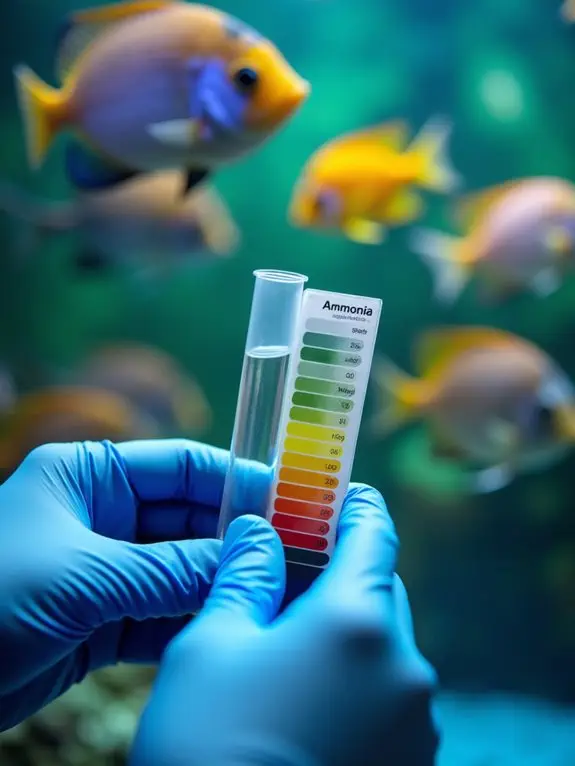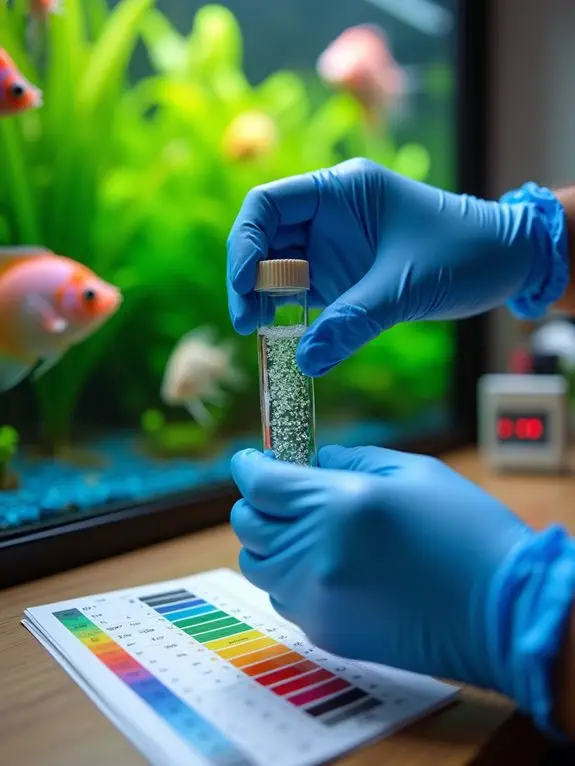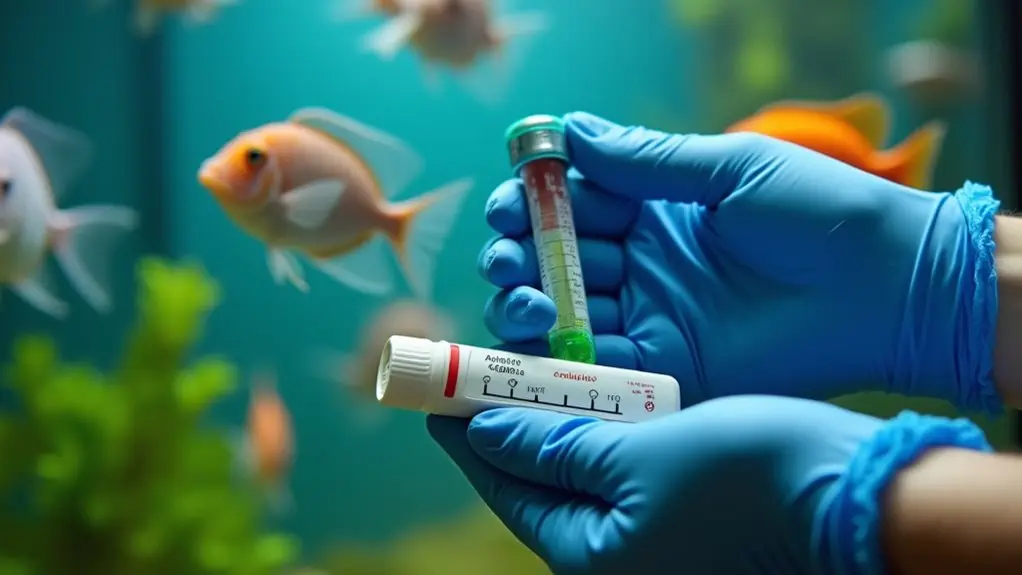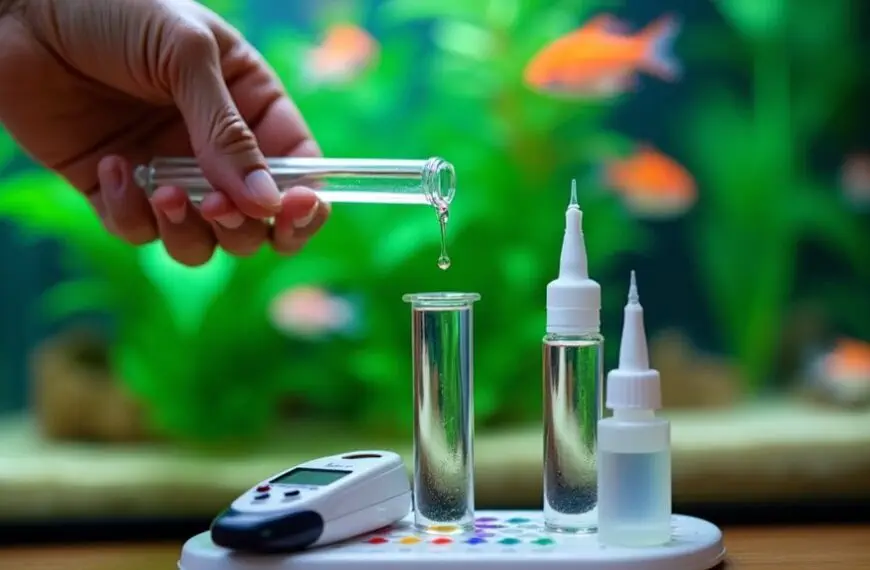Weekly ammonia testing acts as your first line of defense against a silent killer in your aquarium. This toxic compound, produced from fish waste and uneaten food, can quickly harm your fish’s gills, causing them to gasp at the surface and become lethargic. Regular testing helps you catch dangerous spikes before they damage your underwater community, allowing for immediate intervention with water changes or conditioners. Discover how this simple habit can dramatically extend your fish’s lifespan.
Contents
- 1 The Silent Killer: Understanding Ammonia Toxicity in Aquariums
- 2 Signs Your Fish Are Suffering From Elevated Ammonia Levels
- 3 The Nitrogen Cycle: How Ammonia Builds Up and Processes
- 4 Weekly Testing Schedule: When and How to Check Ammonia
- 5 Emergency Response: What to Do When Ammonia Spikes
- 6 Preventative Measures to Keep Ammonia Levels in Check
- 7 Frequently Asked Questions
- 8 Final Thoughts
The Silent Killer: Understanding Ammonia Toxicity in Aquariums
Ammonia, the invisible enemy lurking in your aquarium, can devastate your underwater community before you even notice something’s wrong. This toxic compound builds up from various ammonia sources, including fish waste, uneaten food, and decaying plant matter.
Your beautiful tank can transform into a deadly environment overnight if you’re not monitoring water chemistry regularly.
When ammonia levels rise, your fish will show distress signals—gasping at the surface, developing red gills, or becoming lethargic. By then, they’re already suffering! Even low concentrations can burn delicate gill tissues and compromise immune systems.
Think of it like carbon monoxide in your home—you can’t see it, but it’s silently harming your aquatic friends. That’s why weekly testing isn’t just a suggestion—it’s essential for keeping your underwater paradise thriving. Regular testing helps ensure that ammonia levels remain at 0 ppm to prevent toxicity and maintain a safe environment for your fish.
Signs Your Fish Are Suffering From Elevated Ammonia Levels
Your fish will show clear warning signs when ammonia levels rise too high in your tank.
Look for red or inflamed gills, along with fish gasping at the water’s surface as they struggle to breathe in the toxic environment.
You’ll also notice your once-active fish becoming lethargic, often hiding away in corners or decorations as their health deteriorates from the invisible threat. Elevated ammonia levels must be maintained at 0 ppm to avoid toxicity and distress behaviors.
Red/Inflamed Gills
When elevated ammonia levels attack your fish, one of the first visible signs you’ll notice is red or inflamed gills. This inflammation isn’t just a cosmetic issue – it’s a serious warning that your fish’s gill health is compromised.
Healthy gills should appear vibrant but not irritated, allowing your aquatic friends to process oxygen efficiently. As ammonia burns delicate gill tissue, your fish can’t extract oxygen properly from the water.
You might spot them gasping near the surface or breathing rapidly, desperately trying to compensate for declining oxygen levels in their bloodstream.
Don’t wait until you see your fish “coughing” at the tank’s surface! By testing ammonia weekly, you’ll catch these problems before they cause permanent gill damage. Additionally, understanding that ammonia spikes can lead to severe health issues will motivate you to maintain consistent water quality testing.
Gasping at Surface
Closely connected to red gill inflammation, fish gasping at the water’s surface often signals an ammonia emergency in your tank.
When you notice this surface behavior, your fish are desperately seeking oxygen that they can’t extract through their damaged gills. The visible struggle of gasping fish should trigger immediate action on your part.
Here’s what happens when ammonia levels rise:
- Fish swim to the surface where oxygen concentration is highest.
- They open and close their mouths rapidly, creating a distinctive gasping motion.
- This behavior becomes more frequent and affects more fish as ammonia levels increase.
Don’t mistake this for normal feeding behavior—gasping fish aren’t excitedly waiting for food.
They’re fighting to survive. Your quick response with water changes and ammonia treatments could mean the difference between life and death. Regular testing for ammonia levels is crucial to prevent such emergencies.
Lethargy and Hiding
Unlike the frantic gasping behaviors at the water’s surface, lethargy and hiding represent the opposite end of ammonia poisoning symptoms—but they’re equally concerning.
When your once-active fish suddenly spends most of its time tucked away in decorations or plants, it’s sending you a clear stress indicator.
You might notice your fish moving sluggishly, showing little interest in food, or resting at the bottom of the tank for extended periods.
These changes in fish behavior aren’t just personality shifts—they’re cries for help.
Your aquatic pets are fundamentally trying to conserve energy and find refuge from the toxicity in their environment.
Think of it as their version of calling in sick and staying in bed. Regular testing of ammonia levels is crucial to detecting any potential issues early on and ensuring a healthy aquarium.
The Nitrogen Cycle: How Ammonia Builds Up and Processes
Your aquarium’s health depends on beneficial bacteria colonies that convert harmful ammonia into less toxic compounds. These microscopic helpers establish a biological filtration system, breaking down fish waste and uneaten food that would otherwise raise ammonia to dangerous levels. You’ll need to monitor the balance between your tank’s bioload (fish, food, waste) and your bacterial population, as an overloaded system can’t process ammonia quickly enough to keep your fish safe. Regular testing is essential for ensuring that ammonia levels remain at zero to protect the health of your aquatic ecosystem.
Beneficial Bacteria Colonies
Beneath the surface of your aquarium, a microscopic army of beneficial bacteria works tirelessly to keep your fish healthy and your water clean.
These tiny heroes transform toxic ammonia into safer compounds through a process called nitrification. Without them, your aquarium would quickly become uninhabitable.
Your beneficial bacteria colonies develop in three key stages:
- Initial colonization – bacteria begin settling on surfaces within 1-2 weeks
- Population explosion – colonies rapidly expand as they process available ammonia
- Maturation – a balanced ecosystem forms, maintaining stable aquarium health
When you test for ammonia weekly, you’re actually checking on your bacterial workforce.
Rising ammonia levels signal that your bacteria need support—perhaps through reduced feeding, partial water changes, or commercial bacteria boosters. Regular monitoring of water parameters is vital to ensuring optimal conditions for these beneficial bacteria.
Bioload And Balance
Every healthy aquarium depends on an essential biological process called the nitrogen cycle, where waste materials are transformed into less harmful compounds. Your fish produce waste, uneaten food decays, and plants shed leaves—all contributing to your tank’s bioload.
When this bioload exceeds what your beneficial bacteria can process, ammonia levels spike, threatening your aquatic friends.
Effective bioload management is vital for maintaining this delicate ecosystem. You’ll need to take into account how many fish you keep, how often you feed them, and your tank’s size.
Optimal conditions for this cycle are critical to ensure the well-being of your fish.
If ammonia readings climb, you’re witnessing nature’s warning system in action! Balance restoration might require water changes, reducing feeding, or even rehoming some fish.
Weekly Testing Schedule: When and How to Check Ammonia

While maintaining a healthy aquarium requires diligence, establishing a consistent testing routine doesn’t have to be complicated. Your ammonia testing frequency should be weekly, especially during the first few months of a new tank setup.
You’ll quickly develop a rhythm that feels less like a chore and more like a check-in with your underwater friends.
Follow these simple steps for effective monitoring:
- Choose a specific day each week (Sunday mornings work great for many hobbyists) to create a consistent habit.
- Test before water changes to get accurate readings of accumulated ammonia.
- Record results in a notebook or digital app to track patterns over time. Regular testing ensures stable living conditions that aid fish health and promote longevity.
Don’t skip testing even when everything looks fine—invisible ammonia spikes can occur between visual inspections!
Emergency Response: What to Do When Ammonia Spikes
When you discover an ammonia spike in your aquarium, quick action can mean the difference between healthy fish and a tank disaster. Your first step should be an immediate 50% water change to dilute toxin levels.
Remember, your fish are fundamentally swimming in poison until you fix this!
Several effective ammonia detoxification methods can help during these emergencies. Add a quality water conditioner that specifically neutralizes ammonia – products containing Prime or AmGuard work wonders in these situations. Additionally, regular water changes can help prevent future spikes by maintaining water quality.
Don’t forget to temporarily reduce feeding, as uneaten food compounds the problem.
For severe spikes (readings above 1 ppm), you might need multiple emergency water changes over 24 hours.
Monitor levels closely afterward, and consider adding beneficial bacteria products to jump-start the nitrogen cycle.
Your quick response now will save you from the heartbreak of losing your aquatic friends!
Preventative Measures to Keep Ammonia Levels in Check

Rather than constantly battling ammonia emergencies, smart aquarists focus on prevention.
You’ll save time, money, and fish lives by establishing good habits now. Water conditioning products are your first line of defense, instantly neutralizing harmful ammonia while your biological filter catches up.
For long-term ammonia removal success, follow these three critical steps:
- Don’t overstock your tank—fewer fish means less waste and lower ammonia production.
- Feed appropriately—only what your fish can consume in 2-3 minutes to prevent uneaten food decomposition.
- Establish a consistent maintenance schedule—regular water changes of 25-30% weekly remove accumulated toxins.
Frequently Asked Questions
Can Test Strips or Liquid Test Kits Measure Ammonia More Accurately?
Liquid test kits measure ammonia more accurately than test strips. You’ll get better precision with liquid kits, as they provide clearer readings. Test strip accuracy is generally lower due to their simplified color-matching system.
How Do Temperature and Ph Affect Ammonia Toxicity Levels?
Temperature effects amplify ammonia toxicity in warmer water. But pH influence is even more critical—as pH rises, ammonia becomes markedly more toxic. You’ll need stricter monitoring when you’re dealing with higher temperatures or pH levels.
Do Different Fish Species Tolerate Ammonia Differently?
Yes, different fish species have varying ammonia tolerance levels. You’ll find that species sensitivity ranges widely—some fish like goldfish can endure higher concentrations, while others like discus are extremely vulnerable to even minimal ammonia exposure.
Should I Test Ammonia After Adding New Plants?
Yes, you should test ammonia after adding new plants. They can release ammonia from decaying matter or disturbed substrate. Regular testing guarantees plant health and helps identify unexpected ammonia sources in your aquarium ecosystem.
Can Overfeeding Directly Cause Ammonia Spikes?
Yes, overfeeding directly causes ammonia spikes. When you overfeed, uneaten food decomposes in your tank, becoming a significant ammonia source. This is one of the most common overfeeding consequences affecting water quality.
Final Thoughts
By testing your aquarium’s ammonia levels weekly, you’re not just following a routine—you’re protecting your underwater friends. Think of it as a health check-up that prevents disaster before it strikes. When you monitor regularly, you’ll catch problems early, maintain the delicate balance your fish need, and enjoy a thriving aquarium with less stress. Your finned family deserves this small commitment that makes all the difference in their world.












